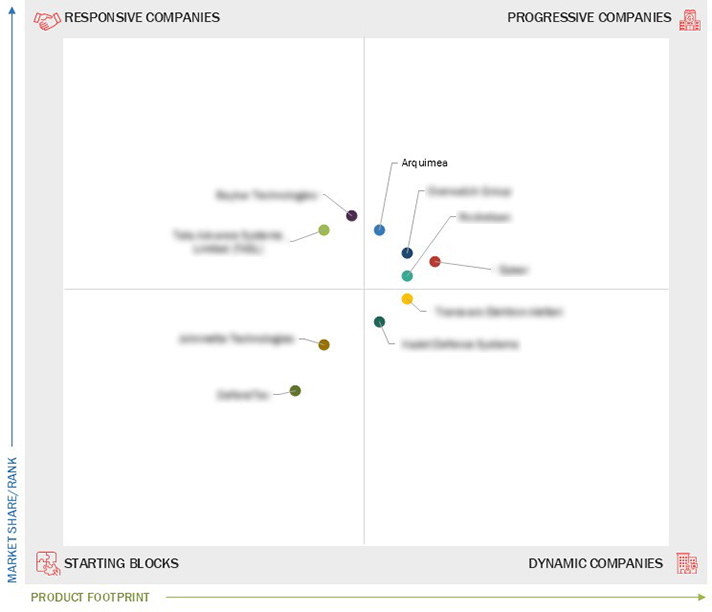Comparing 10 vendors in Loitering Munition Startups across 0 criteria.
Loitering munitions are advanced aerial weapons often referred to as suicide drones, kamikaze drones, or explosive drones. These munitions are designed for precise and responsive engagement. Equipped with warheads, they can linger in a target area for extended periods until they detect an enemy presence, at which point they can directly impact the target. Loitering munitions occupy a unique position between cruise missiles and unmanned combat aerial vehicles (UCAVs).
Market Leadership Quadrant
1.1 Study Objectives
1.2 Market Definition
1.3 Study Scope
1.3.1 Markets Covered and Regional Scope
1.3.2 Inclusions and Exclusions
1.3.3 Years Considered
1.4 Currency Considered
1.5 Stakeholders
2.1 Introduction
2.2 Market Dynamics
2.2.1 Drivers
2.2.1.1 Integration of AI and sensors into loitering munitions
2.2.1.2 Defense modernization initiatives
2.2.1.3 Cost-effectiveness and versatility
2.2.1.4 Increasing demand for precision strike capabilities
2.2.2 Restraints
2.2.2.1 High procurement costs
2.2.2.2 Operational limitations
2.2.2.3 Regulatory challenges
2.2.3 Opportunities
2.2.3.1 Focus on enhancing border security and counter-insurgency
operations
2.2.3.2 Advancements in countermeasure technologies
2.2.3.3 Significance of loitering munitions in naval warfare and
maritime surveillance
2.2.4 Challenges
2.2.4.1 Technical limitations and reliability concerns
2.2.4.2 Potential threats to safety and violation of privacy
2.3 Ecosystem Analysis
2.4 Trends and Disruptions Impacting Customer Business
2.5 Value Chain Analysis
2.6 Operational Data
2.7 Macroeconomic Outlook
2.8 Technology Analysis
2.8.1 Key Technologies
2.8.1.1 Lightweight sensors and guidance systems
2.8.1.2 Advanced communications systems
2.8.2 Complementary Technologies
2.8.2.1 BVLOS operations
2.8.2.2 Counter-unmanned aerial systems
2.8.2.3 Security protocols
2.8.3 Adjacent Technologies
2.8.3.1 Innovative battery technologies
2.8.3.2 Electro-optical and infrared sensors
2.9 Pricing Analysis
2.9.1 Indicative Pricing Analysis of Loitering Munitions Offered By Key
Players
2.9.2 Indicative Pricing Analysis of Loitering Munitions, By Region
2.10 Loitering Munition Defense Programs
2.11 Product Comparison
2.11.1 Product Comparison, By Type
2.11.2 Product Comparison, By Similar Weapon
2.12 Trade Analysis
2.12.1 Import Data (HS Code 930690)
2.12.2 Export Data (HS Code 930690)
3.1 Introduction
3.2 Key Player Strategies/Right to Win, 2020–2024
3.3 Revenue Analysis, 2019–2023
3.4 Market Share Analysis, 2023
3.5 Company Evaluation Matrix: Start-Ups/SMEs, 2023
3.5.1 Progressive Companies
3.5.2 Responsive Companies
3.5.3 Dynamic Companies
3.5.4 Starting Blocks
3.5.5 Competitive Benchmarking
3.5.5.1 List of start-ups/SMEs
3.5.5.2 Competitive benchmarking of start-ups/SMEs
3.6 Company Valuation and Financial Metrics
3.7 Brand/Product Comparison
3.8 Competitive Scenario
3.8.1 Deals
3.8.2 Others
4.1 ARQUIMEA
4.1.1 Business overview
4.1.2 Products/Solutions/Services offered
4.1.3 Recent developments
4.2 ROKETSAN
4.2.1 Business overview
4.2.2 Products/Solutions/Services offered
4.2.3 Recent developments
4.3 TATA ADVANCED SYSTEMS LIMITED
4.3.1 Business overview
4.3.2 Products/Solutions/Services offered
4.3.3 Recent developments
4.4 SPEAR
4.4.1 Business overview
4.4.2 Products/Solutions/Services offered
4.4.3 Recent developments
4.5 TRANSVARO ELEKTRON ALETLERI
4.5.1 Business overview
4.5.2 Products/Solutions/Services offered
4.5.3 Recent developments
4.6 BAYKAR TECHNOLOGIES
4.6.1 Business overview
4.6.2 Products/Solutions/Services offered
4.6.3 Recent developments
4.7 OVERWATCH GROUP
4.7.1 Business overview
4.7.2 Products/Solutions/Services offered
4.7.3 Recent developments
4.8 KADET DEFENCE SYSTEMS
4.8.1 Business overview
4.8.2 Products/Solutions/Services offered
4.8.3 Recent developments
4.9 DEFENDTEX
4.9.1 Business overview
4.9.2 Products/Solutions/Services offered
4.9.3 Recent developments
4.10 JOHNNETTE TECHNOLOGIES
4.10.1 Business overview
4.10.2 Products/Solutions/Services offered
4.10.3 Recent developments


 Army Recognition
Army Recognition
 May 2025
May 2025

